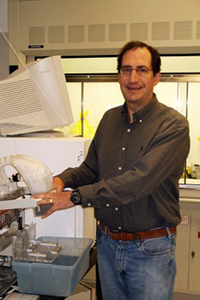Molecular Picture Points the Way to Better Antipsychotic Medications
Molecular Picture Points the Way to Better Antipsychotic Medications

A new high-resolution image of the antipsychotic drug risperidone (Risperdal) bound to the brain receptor through which it exerts its effects could help researchers design safer and more effective medications.
Risperidone helps control the symptoms of schizophrenia, bipolar disorder, and other psychotic disorders. It is also used to reduce irritability in people with autism. Like other antipsychotic medications, it works by suppressing signaling from a type of dopamine receptor in the brain called D2. It’s one of five variants of the receptor found in the brain, each with small but highly consequential differences.
Unfortunately, antipsychotic medicines can cause significant side effects. Most of these effects, which include potentially serious movement problems called extra-pyramidal side effects (EPS), as well as weight gain, dizziness, constipation and heart problems, are thought to be due to drug interactions with receptors in the brain that resemble the drug’s intended target. A clear picture of how D2 dopamine receptors differ from other types of dopamine receptors is needed to enable researchers to develop more selective drugs.
BBRF Scientific Council Member Bryan L. Roth, M.D., Ph.D., a pharmacologist at the University of North Carolina Chapel Hill Medical School, has led an effort over several years to determine the structure of the drug-bound receptor.
His team’s latest findings, reported online January 24 in the journal Nature, show a level of detail that approaches the scale of individual atoms, how the risperidone molecule interacts with the D2 receptor.
Their picture reveals several surprising features of the complex, including key structural distinctions between the D2 receptor and other types of dopamine receptors whose structures have been solved. The findings give scientists important clues about how to design next-generation drugs that bind more specifically to their targets without interfering with signaling elsewhere in the brain.
Related Webinar: Searching for the Seeds of Psychosis



